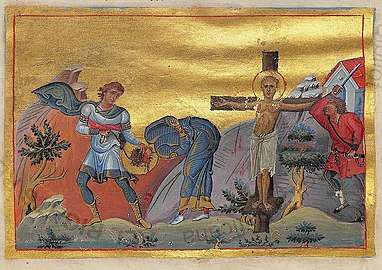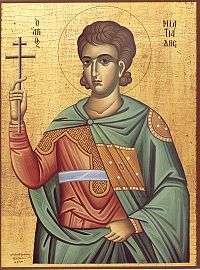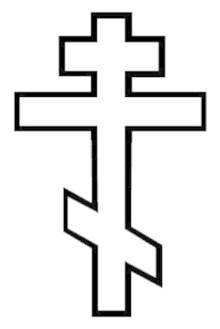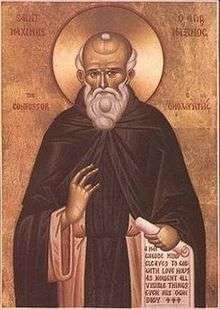December 10 (Eastern Orthodox liturgics)
December 9 - Eastern Orthodox liturgical calendar - December 11
All fixed commemorations below celebrated on December 23 by Eastern Orthodox Churches on the Old Calendar.[note 1]
For December 10th, Orthodox Churches on the Old Calendar commemorate the Saints listed on November 27.
Saints
- Martyrs Menas the Most Eloquent, Hermogenes, and Eugraphus, of Alexandria (c. 313)[1][2][3][note 2]
- Martyr Gemellus of Paphlagonia (Gemellus of Ancyra), cruelly tortured and crucified (361))[3][5][6][note 3]
- Martyr Theotecnus, by the sword.[8][note 4]
- Martyr Marianus, by stoning.[9]
- Martyr Eugenios, beaten to death.[10]
- Venerable Thomas Dephourkinos of Mt. Kyminas in Bithynia (Thomas the Righteous) (10th century)[3][11][12][note 5]
Pre-Schism Western saints
- Saints Carpophorus and Abundius, a priest and his deacon who suffered under Diocletian (c. 290-300)[14][note 6]
- Virgin-martyr Eulalia of Barcelona, the most famous virgin-martyr in Spain, burnt at the stake under Diocletian (304)[14][note 7][note 8]
- Saint Julia of Mérida (Eulalia of Mérida), a martyr together with St Eulalia, in Mérida in Spain under Diocletian (304)[14][note 9]
- Saint Mercurius and Companions, at Lentini in Sicily, soldiers who were beheaded under the governor Tertyllus, in the time of Emperor Licinius (c. 308)[7][14][note 10]
- Saint Deusdedit of Brescia, Bishop of Brescia in Italy, played a leading part in the Councils against Monothelitism (c. 700)[14]
- Pope Saint Miltiades, Pope of Rome from 311 to 314, who condemned Donatism and was venerated as a martyr on account of his many sufferings during the persecution of Maximian (314)[14][note 11]
- Pope Saint Gregory III, who was much troubled by Iconoclasm and the raids of the Lombards (741)[14]
- Saint Sindulf of Vienne (Sindulphus), the thirty-first Bishop of Vienne in France (c. 669)[14]
- Saint Guitmarus, fourth Abbot of Saint-Riquier in France (765)[14]
- Saint Hildemar (Hildemanus), a monk at Corbie who became Bishop of Beauvais in France in 821 (844)[14]
Post-Schism Orthodox saints
- Blessed Jovan Branković, King of Serbia (1503), and his parents Stephen the Blind (1468) and Saint Angelina (Brancovic) (16th century)[3][15]
- Saint Ioasaph (Gorlenko) of Belgorod (1754)[3][16] (see also September 4 )
New martyrs and confessors
- New Hieromartyr Alexander (Shklaev) of Perm, Protopresbyter (1918)[17][18][19]
- New Hieromartyr Jacob (Shestakov) of Perm, Priest (1918)[17][18][19]
- Hieromartyr Eugraphus (Pletnev) of Perm, Priest, and his son, Mikhail Pletnev (1918)[17][18][19]
- New Hieromartyrs of Ryazan: Protopresbyters - Anatolius Pravdoliubov, Alexander Tuberovsky, Eugene Kharkov, and Constantine Bazhanov (1937),[17][18][19] and with them:
- New Hieromartyr Nicholas Karasiov, Priest.[17][18][19]
- Martyrs Peter Grishin, Michael Yakunkin, Eusebius Tryakhov, Dorotheus Klimashev, Laurentius Kogtyev, Gregory Berdenev.[17][18][19]
- Virgin-martyrs Alexandra Ustiukhina and Tatiana Yegorova.[17][18][19]
- New Hieromartyr Michael Kobozev, Priest.[17][19]
- New Hieromartyr Sergius Sorokin, Hieromonk of Sreznevo (Ryazan) (1937)[3][17][19]
- Virgin-martyr Eudocia (after 1937)[17]
- New Hieromartyr Protopresbyter Nicholas Rozov of Yaroslavl-Rostov (1938)[18][19]
- New Hieromartyr Alexis Vvedensky, Priest (1938)[17][19]
- Virgin-martyrs Anna Ivashkina and Tatiana Byakirevoy, Confessors (1948)[17][19]
- Virgin-martyr Thecla Makusheva, Confessor (1954)[17][19]
- Venerable New Nun-Confessor Anna Stoliarova, Schema-nun of Sreznevo, Ryazan (1958)[3][17][19]
Other commemorations
- Synaxis of the Archangel Michael at the Adda River in northern Italy, before the Battle of Coronate (689)[20]
Icon gallery
 Martyrdom of St. Gemellus of Paphlagonia. (Menologion of Basil II, 10th century)
Martyrdom of St. Gemellus of Paphlagonia. (Menologion of Basil II, 10th century) Virgin-martyr Eulalia of Barcelona, the most famous virgin-martyr in Spain, burnt at the stake. (Barcelona Cathedral).
Virgin-martyr Eulalia of Barcelona, the most famous virgin-martyr in Spain, burnt at the stake. (Barcelona Cathedral). Icon of Pope Miltiades.
Icon of Pope Miltiades. Fresco of Blessed Jovan Branković in Krušedol Monastery.
Fresco of Blessed Jovan Branković in Krušedol Monastery. Saint Ioasaph of Belgorod.
Saint Ioasaph of Belgorod.
Notes
- The notation Old Style or (OS) is sometimes used to indicate a date in the Julian Calendar (which is used by churches on the "Old Calendar").
The notation New Style or (NS), indicates a date in the Revised Julian calendar (which is used by churches on the "New Calendar"). - The Holy Martyrs Minos, Hermogenes and Eugraphos suffered for their faith in Christ under the emperor Maximian (305-313). Saint Minos was sent by the emperor from Athens to Alexandria to suppress the riots that had arisen between the Christians and the pagans. Distinguished for his gift of eloquence, Minos instead openly began to preach the Christian faith and he converted many pagans to Christ. Learning of this, Maximian dispatched Hermogenes to the Alexandria district to conduct a trial over the saints, and moreover was given orders to purge the city of Christians. Hermogenes, although he was a pagan, was distinguished however by his reverent bearing. And struck by the endurance of Saint Minos under torture and by his miraculous healing after the cruel torments, he also came to believe in Christ. Maximian himself then arrived in Alexandria. Neither the astonishing stoic endurance under torture of Saints Minos and Hermogenes, nor even the miracles of these days manifest of God in this city, in any way mollified the emperor, but instead vexed him all the more. The emperor personally stabbed Saint Eugraphos, the secretary of Saint Minos, and then gave orders to behead the holy Martyrs Minos and Hermogenes. The remains of the holy martyrs, cast into the sea in an iron chest, were afterwards found (about this see under 17 February) and transferred to Constantinople. The emperor Justinian built a church in the name of the holy Martyr Minos of Alexandria. Saint Joseph the Melodist (Comm. 4 April) composed a canon in honour of the holy martyrs.[4]
- "At Ancyra, in Galatia, St. Gemellus, martyr, who, after severe torments, consummated his martyrdom by being crucified, under Julian the Apostate."[7]
- See also: (in Greek) Θεότεκνος. Βικιπαίδεια. (Greek Wikipedia).
- Born at an unknown date at the foot of Mt. Kyminaion (= Mt. Kyminas in Bithynia?) to middle-class (autarkeis) parents, Thomas had a religious education, studying the Psalter, the apostolic epistles, and other ecclesiastic writings. He became a monk, and was then appointed hegoumenos of a monastery newly founded by the magnate Galolektes on the Sangarios River. After some years he retired to a hermitage, which soon became a monastery. For years he was sorely afflicted by demonic attacks in the form of mosquitoes, flies, wasps and snakes, from which he was finally delivered after prayer to God. Thomas was famed for his gift of healing and clairvoyance, as shown when he was able to reply to a pittakion sent by Leo VI (886-912) without opening and reading it. The allusion to Leo is the only chronological indication in his late synaxarion notice, found in a 15th-century manuscript. Grégoire suggests that Thomas is to be identified with the palace priest who blessed the marriage of Leo VI and Zoe in 906.[13]
- "The same day, Saints Carpophorus, priest, and Abundius, deacon, who became martyrs in the persecution of Diocletian. They were first most cruelly beaten with rods, then imprisoned and denied food and drink; being racked a second time and again thrown into prison, they were finally beheaded."[7]
- Prudentius wrote a long hymn describing her martyrdom and she is mentioned by other writers. Born in Mérida, aged thirteen she was burnt at the stake there under Diocletian.
- "At Merida, in Spain, in the time of Maximian, the martyrdom of the holy virgin Eulalia, who, at twelve years of age, suffered many torments for the confession of Christ, by order of the governor Dacian. Finally she was stretched on the rack, torn with iron hooks, had her sides burned with flaming torches, and fire being forced down her throat, she expired."[7]
- "Again, in the same city, St. Julia, virgin and martyr, the companion of blessed Eulalia, who would not be separated from her when the latter went to suffer."[7]
- A group of soldiers told to escort Christian prisoners to their place of execution in Lentini in Sicily. The soldiers were so impressed by the prisoners that they too declared themselves believers in Christ and all of them were beheaded together.
- "AT Rome, pope St. Melchiades, who, having suffered much in the persecution of Maximian, rested in the Lord when peace was given to the Church."[7]
gollark: Any image which does not contain red does not contain red.
gollark: Sure, that might be "obviously a tautology" and "an unhelpful thing to say", but too bad.
gollark: Purely nonred colors.
gollark: Okay, fiiiiiiine, just any picture which isn't purely black or purely a nonred color.
gollark: This is you then.
References
- Great Synaxaristes: (in Greek) Οἱ Ἅγιοι Μηνᾶς, Ἑρμογένης καὶ Εὔγραφος. 10 Δεκεμβρίου. ΜΕΓΑΣ ΣΥΝΑΞΑΡΙΣΤΗΣ.
- Martyr Menas of Alexandria. OCA - Feasts and Saints.
- December 10/23. Orthodox Calendar (PRAVOSLAVIE.RU).
- The Holy Martyrs Minos, Hermogenes and Eugraphos. HOLY TRINITY RUSSIAN ORTHODOX CHURCH (A parish of the Patriarchate of Moscow).
- Great Synaxaristes: (in Greek) Ὁ Ἅγιος Γέμελλος ὁ Μάρτυρας. 10 Δεκεμβρίου. ΜΕΓΑΣ ΣΥΝΑΞΑΡΙΣΤΗΣ.
- Martyr Gemellus of Paphlagonia. OCA - Feasts and Saints.
- The Roman Martyrology. Transl. by the Archbishop of Baltimore. Last Edition, According to the Copy Printed at Rome in 1914. Revised Edition, with the Imprimatur of His Eminence Cardinal Gibbons. Baltimore: John Murphy Company, 1916. pp. 379-380.
- Great Synaxaristes: (in Greek) Ὁ Ἅγιος Θεότεκνος ὁ Μάρτυρας. 10 Δεκεμβρίου. ΜΕΓΑΣ ΣΥΝΑΞΑΡΙΣΤΗΣ.
- Great Synaxaristes: (in Greek) Ὁ Ἅγιος Μαριανὸς ὁ Μάρτυρας. 10 Δεκεμβρίου. ΜΕΓΑΣ ΣΥΝΑΞΑΡΙΣΤΗΣ.
- Great Synaxaristes: (in Greek) Ὁ Ἅγιος Εὐγένιος ὁ Μάρτυρας. 10 Δεκεμβρίου. ΜΕΓΑΣ ΣΥΝΑΞΑΡΙΣΤΗΣ.
- Great Synaxaristes: (in Greek) Ὁ Ὅσιος Θωμᾶς ὁ Δεφουρκινός. 10 Δεκεμβρίου. ΜΕΓΑΣ ΣΥΝΑΞΑΡΙΣΤΗΣ.
- Venerable Thomas of Bithynia. OCA - Feasts and Saints.
- Alexander Kazhdan and Alice-Mary Talbot (Eds.). "Thomas Dephourkinos". In: DUMBARTON OAKS HAGIOGRAPHY DATABASE. Washington, D.C.: Dumbarton Oaks, Trustees for Harvard University, 1998. p.109.
- December 10. Latin Saints of the Orthodox Patriarchate of Rome.
- Blessed John the King of Serbia and his parents. OCA - Feasts and Saints.
- St Joasaph the Bishop of Belgorod. OCA - Feasts and Saints.
- December 23 / December 10. HOLY TRINITY RUSSIAN ORTHODOX CHURCH (A parish of the Patriarchate of Moscow).
- The Autonomous Orthodox Metropolia of Western Europe and the Americas (ROCOR). St. Hilarion Calendar of Saints for the year of our Lord 2004. St. Hilarion Press (Austin, TX). p.92.
- (in Russian) 10 декабря (ст.ст.) 23 декабря 2013 (нов. ст.). Русская Православная Церковь Отдел внешних церковных связей. (DECR).
- Great Synaxaristes: (in Greek) Σύναξις Ἀρχιστράτηγου Μιχαὴλ ἐν τοῖς Ἄδδᾳ (ἢ Ἀδδᾷ). 10 Δεκεμβρίου. ΜΕΓΑΣ ΣΥΝΑΞΑΡΙΣΤΗΣ.
Sources
- December 10/23. Orthodox Calendar (PRAVOSLAVIE.RU).
- December 23 / December 10. HOLY TRINITY RUSSIAN ORTHODOX CHURCH (A parish of the Patriarchate of Moscow).
- December 10. OCA - The Lives of the Saints.
- The Autonomous Orthodox Metropolia of Western Europe and the Americas (ROCOR). St. Hilarion Calendar of Saints for the year of our Lord 2004. St. Hilarion Press (Austin, TX). p. 92.
- December 10. Latin Saints of the Orthodox Patriarchate of Rome.
- The Roman Martyrology. Transl. by the Archbishop of Baltimore. Last Edition, According to the Copy Printed at Rome in 1914. Revised Edition, with the Imprimatur of His Eminence Cardinal Gibbons. Baltimore: John Murphy Company, 1916. pp. 379–380.
Greek Sources
- Great Synaxaristes: (in Greek) 10 ΔΕΚΕΜΒΡΙΟΥ. ΜΕΓΑΣ ΣΥΝΑΞΑΡΙΣΤΗΣ.
- (in Greek) Συναξαριστής. 10 Δεκεμβρίου. ECCLESIA.GR. (H ΕΚΚΛΗΣΙΑ ΤΗΣ ΕΛΛΑΔΟΣ).
Russian Sources
- (in Russian) 23 декабря (10 декабря). Православная Энциклопедия под редакцией Патриарха Московского и всея Руси Кирилла (электронная версия). (Orthodox Encyclopedia - Pravenc.ru).
- (in Russian) 10 декабря (ст.ст.) 23 декабря 2013 (нов. ст.). Русская Православная Церковь Отдел внешних церковных связей. (DECR).
This article is issued from Wikipedia. The text is licensed under Creative Commons - Attribution - Sharealike. Additional terms may apply for the media files.

